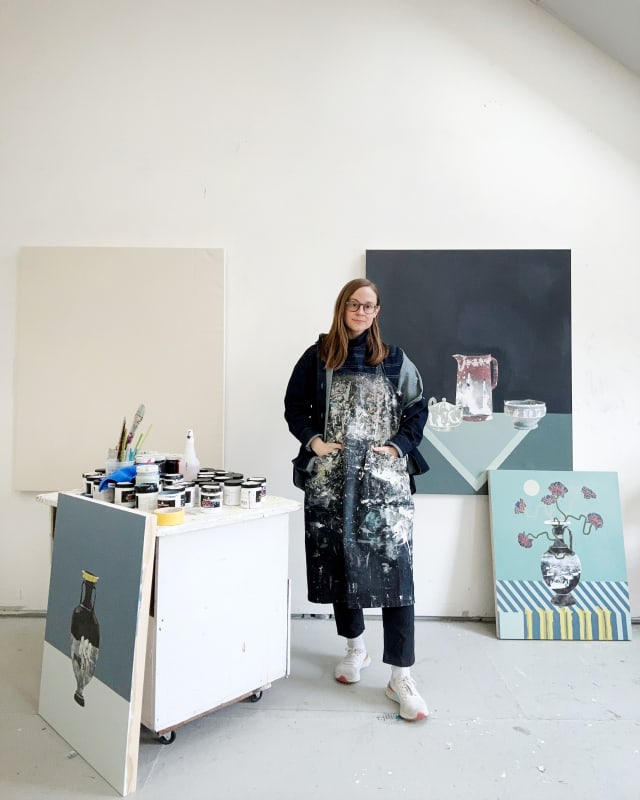This is new for me.
Back in April, I had the pleasure and the privilege of a month at Vermont Studio Center where, in a sleepy town more Canada than Vermont, I met an artist named Lizzie Gill.
What began as a brief studio visit was made not-so-brief by my running my mouth off about metahistorical criticism, mid century Americana propaganda, and, of course, the Greeks (being so myself, I can’t say no to a good pithos.) I could’ve stood in front of Lizzie’s work that whole month, but, well, we both had work to do. I’m grateful to say, though, that this initial conversation blossomed into another, then another, and I was able to learn about Wedgwood and heirlooms, Pandora’s curse, her gift, of boundless hope, and the packing up of a family home that inspired this series that has so inspired me.
Through these coffee chats in Vermont, I’m lucky enough to say I now know an artist as steeped in research as craft, in intellect as empathy. Lizzie’s work is both seductive and subversive (arguably all the more subversive because it is so seductive.) I’m sure you’ll agree that it’s impossible not to be, well, beguiled. But underneath her photo transfers and deftly-hued house paint there is a paradigm shift at work.
As a filmmaker, a theatermaker, I’m familiar with the ways in which shadows have been manipulated at the hands of one’s agendas (sometimes called, simply, art.) In Lizzie’s hands, these shadows interrogate everything from perpetuated myths of American excellence to the ways in which art preservation & curation is tied up in, often, those self-same motives. They unsettle gendered signifiers (flowers, fine china, housemaking, oh my!) and suggest that it is not from the bodybuilders and space race that any potential growth forms. The flowers in these vessels, placed just so within the frame, deny any uncomplicated notion of “pretty,” and what, ultimately, is arranged for us?
Is it the men that hold these arrangements who sickly their color, stunt their growth, or is it that, regardless of the uncanny mise en scene of their dining setting, regardless of the little race cars and moremoremore centerpieces that oh, so loudly call our attention, these flowers are determined to blossom beyond the borders of the canvas, beyond the histories in which they’ve been placed, and their unromantic, wild growth is not the feminine denied but the feminine in defiance? Taken another way – life, organic, in defiance of life, of history, arranged & prescribed.
As with any fine piece of art, there is no clear answer. Just a wealth of clear questions, should you look beyond the beguiling.
At least, so it seems to me.
It’s perhaps telling of the English major in me that when Lizzie asked for a brief response to her work, I turned around with an ekphrastic poem. I want to be clear – I am not a poet.
But I am Greek.
From Auden responding to the fall of Icarus (or William Carlos Williams responding to that same Brueghel) to Keats’, “Ode to a Grecian Urn,” (to which I’ve made my own kind of ode), the ekphrastic form has been used, classically, to respond to the classical. It’s taken many shapes since then, and what began as an ode to Achilles’ shield in The Illiad has found its way, I might suggest, into works like Scorcese’s completely endearing Hugo.
If you return to the Greek, though, you’ll find ekphrasis is simply anything that describes another thing in vivid detail. Usually an inanimate object. Now, commonly, another work of art. I’ve no pretense of having done that, but what I have found is that my work, my thought, my process has been made all the richer in learning of Lizzie’s. You’ll find in my piece the notes of our conversations, filtered through my own Stendahl Syndrome at having fallen in love with these landscapes of a world almost like ours.
Here, in vivid detail, Lizzie Gill has offered a vision on how our history shapes our present, and how our ways of looking at either define or defy our hopes for the future. In vivid detail, as perennial as that sunmoon watching over every table setting, you’ll find a head & a heart caught up in a timeless conversation. Here, a new kind of ekphrasis.
All we have to do is take a look.
I’m so, so lucky I did.
Joanna Glum is a playwright and filmmaker from California. Her works have been featured at the Edinburgh Fringe and Middlebury New Filmmakers Festivals, published or forthcoming in The Brooklyn Review and Roxane Gay’s The Audacity, and recognized or supported by, amongst others, Vermont Studio Center, The Sachs Program for Arts Innovation, American Zoetrope Screenplay Competition, Yefe Nof Core Residency, and the MLA Annual Convention. She is currently developing a feature film (and a play) about geriatrics, caregiving, and shifting Northern California landscapes. You can find her at www.joannaglum.com. Joanna Glum is a playwright and filmmaker from California. Her works have been featured at the Edinburgh Fringe and Middlebury New Filmmakers Festivals, published or forthcoming in The Brooklyn Review and Roxane Gay’s The Audacity, and recognized or supported by, amongst others, Vermont Studio Center, The Sachs Program for Arts Innovation, American Zoetrope Screenplay Competition, Yefe Nof Core Residency, and the MLA Annual Convention. She is currently developing a feature film (and a play) about geriatrics, caregiving, and shifting Northern California landscapes. You can find her at www.joannaglum.com.

